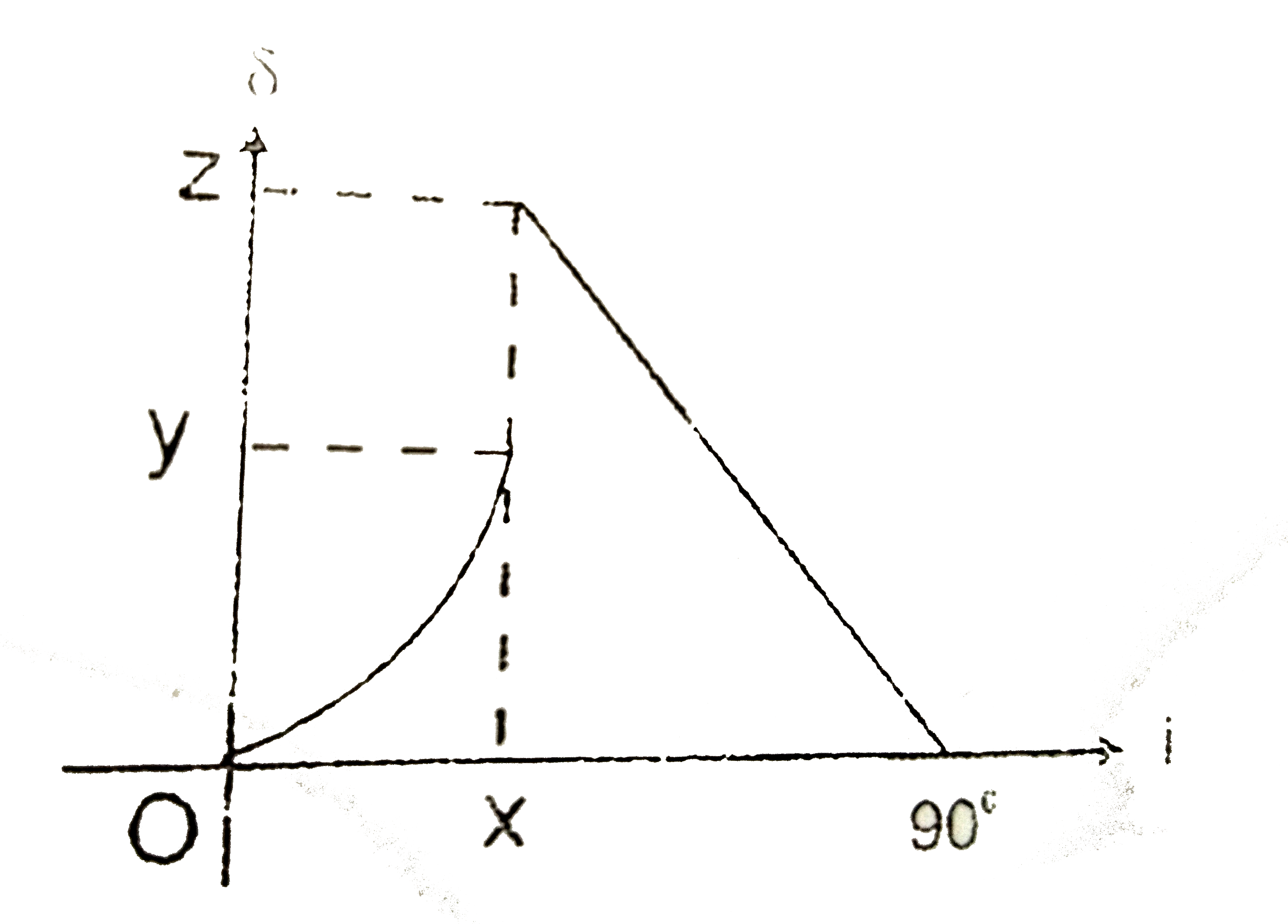Light is incident from glass (μ=1.5) to air. Sketch thevariation of the angle of deviation δ with angle of incident i for 0<i<90∘
The correct Answer is:A
To solve the problem of sketching the variation of the angle of deviation (δ) with the angle of incidence (i) when light travels from glass (with a refractive index μ = 1.5) to air, we can follow these steps:
1. Understanding the Setup:
- Light travels from a denser medium (glass) to a rarer medium (air).
- The refractive index of glass is μ = 1.5.
- The critical angle (c) can be calculated using Snell's law.
2. Calculate the Critical Angle:
- The critical angle (c) can be found using the formula:
sin(c)=n2n1
where n1=1.5 (glass) and n2=1.0 (air).
- Therefore:
sin(c)=1.01.5=23
- Thus, the critical angle c is:
c=sin−1(23)≈41.81∘
3. Analyzing the Angle of Deviation:
- The angle of deviation (δ) is defined as:
δ=r−i
where r is the angle of refraction.
- For i=0∘:
- The light travels straight through, so δ=0∘.
- For 0<i<c:
- The light refracts into the air, and δ increases as i increases.
- For i=c:
- The angle of refraction r=90∘, hence:
δ=90∘−c≈90∘−41.81∘≈48.19∘
- For i>c:
- Total internal reflection occurs. The angle of deviation becomes:
δ=180∘−2i
- As i increases beyond c, δ will start decreasing.
4. Sketching the Graph:
- On the graph, plot i on the x-axis (from 0∘ to 90∘) and δ on the y-axis.
- The graph starts at the origin (0,0).
- As i approaches c, δ increases and reaches a maximum value of approximately 48.19∘.
- After c, the graph will drop sharply as δ decreases due to total internal reflection, continuing to decrease as i approaches 90∘.
Final Graph:
- The graph will have two distinct sections:
1. Increasing Section: From (0,0) to (c,δ).
2. Decreasing Section: From (c,δ) to (90∘,δ).
- Light travels from a denser medium (glass) to a rarer medium (air).
- The refractive index of glass is μ = 1.5.
- The critical angle (c) can be calculated using Snell's law.
- The critical angle (c) can be found using the formula:
sin(c)=n2n1
where n1=1.5 (glass) and n2=1.0 (air).
- Therefore:
sin(c)=1.01.5=23
- Thus, the critical angle c is:
c=sin−1(23)≈41.81∘
- The angle of deviation (δ) is defined as:
δ=r−i
where r is the angle of refraction.
- For i=0∘:
- The light travels straight through, so δ=0∘.
- For 0<i<c:
- The light refracts into the air, and δ increases as i increases.
- For i=c:
- The angle of refraction r=90∘, hence:
δ=90∘−c≈90∘−41.81∘≈48.19∘
- For i>c:
- Total internal reflection occurs. The angle of deviation becomes:
δ=180∘−2i
- As i increases beyond c, δ will start decreasing.
- On the graph, plot i on the x-axis (from 0∘ to 90∘) and δ on the y-axis.
- The graph starts at the origin (0,0).
- As i approaches c, δ increases and reaches a maximum value of approximately 48.19∘.
- After c, the graph will drop sharply as δ decreases due to total internal reflection, continuing to decrease as i approaches 90∘.
- The graph will have two distinct sections:
1. Increasing Section: From (0,0) to (c,δ).
2. Decreasing Section: From (c,δ) to (90∘,δ).
Topper's Solved these Questions
- BOOK - HC VERMA ENGLISHCHAPTER - GEOMETRICAL OPTICSEXERCISE - EXAMPLE9videos
GEOMETRICAL OPTICS
- BOOK - HC VERMA ENGLISHCHAPTER - GEOMETRICAL OPTICSEXERCISE - Question For short Answer18videos
GEOMETRICAL OPTICS
- BOOK - HC VERMA ENGLISHCHAPTER - GEOMETRICAL OPTICSEXERCISE - Objective -27videos
GEOMETRICAL OPTICS
- BOOK - HC VERMA ENGLISHCHAPTER - GAUSS LAWEXERCISE - Short Question7videos
GAUSS LAW
- BOOK - HC VERMA ENGLISHCHAPTER - LIGHT WAVESEXERCISE - Question for short Answer11videos
LIGHT WAVES
Similar Questions
Light is incident from glass to are. The variation of the angle of deviation δ with the angle of incidence i for 0<i<90∘ If the value of (x+y+z) is nπ6 then value of n.
 View Solution
View SolutionLight is incident from glass (μ=1.50) to water (μ=1.33) find the range of the angle of deviation for which there are two angles of incidence.
View SolutionLight is incident from glass (μg=32) to water (μw=43). Find the range of the angle of deviation for refracted light.
View SolutionLight falls from glass (μ=1.5) to air. Find the angle of incidence for which the angle of deviation is 90∘.
View Solution(a) How does the angle of deviation produced by a prism change with increase in the angle of incidence. Draw a curve showing the variation in the angle of deviation with the angle of incidence at a prism surface.
(b) Using the curve in part (a) above, how do you infer that for a given prism, the angle of minimum deviation δmin is unique for a given light.View SolutionHow does the angle of deviation formed by a prism change with the increase in the angle of incidence ?
Draw a graph showing the variation in the angle of deviation with the angle of incidence at a prism surface.View SolutionA ray of light is incident normally on a plane glass slab. What will be (i) the angle of refraction, and (ii) the angle of deviation for the ray ?
View SolutionA ray of light is incident on a medium boundry at polarising angle such that its deviation is 24∘, then angle of incidence is :
View SolutionUnpolarised light is incident from air on a plane surface of a material of refractive index μ. At a particular angle of incidence i, it is found that the reflected and refracted rays are perpendicular to each other. Which of the following options is correct for this situation?
View SolutionUnpolarised light is incident from air on a plane surface of a material of refractive index .μ.. At a particular angle of incidence .I., it is found that the reflected and refracted rays are perpendicular to each other. Which of the following options is correct for this situation?
View Solution

